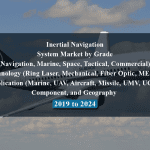OVERVIEW
The Marine Sensors Market is currently valued at USD 1.4 billion in 2024 and will be growing at a CAGR of 6.5% over the forecast period to reach an estimated USD 1.9 billion in revenue in 2029. The marine sensors market is a dynamic sector driven by the increasing demand for advanced monitoring and navigation systems in maritime operations. These sensors play a pivotal role in gathering crucial data related to various parameters such as water quality, weather conditions, vessel performance, and navigation safety. With the expansion of the maritime industry, including shipping, offshore energy, and marine research, the need for reliable and efficient sensor technologies continues to grow. Key developments in sensor technology, such as miniaturization, enhanced accuracy, and wireless connectivity, are enabling real-time data transmission and analysis, thereby improving operational efficiency and safety at sea. Additionally, stringent regulations concerning environmental protection and maritime safety further fuel the adoption of marine sensors across the globe. As a result, the marine sensors market is poised for significant growth in the coming years, driven by innovation and the evolving needs of the maritime industry.
Firstly, the increasing emphasis on maritime safety and security, driven by stringent regulations and rising concerns about environmental protection, drives the demand for advanced sensor technologies to monitor vessel performance, detect hazards, and mitigate risks. Secondly, the expansion of offshore industries such as oil and gas exploration, renewable energy, and aquaculture necessitates the deployment of sensors for monitoring environmental parameters, optimizing operations, and ensuring regulatory compliance. Thirdly, the growing adoption of autonomous and unmanned marine vehicles requires sophisticated sensor systems for navigation, obstacle avoidance, and situational awareness. Moreover, technological advancements such as the Internet of Things (IoT), artificial intelligence (AI), and machine learning (ML) enable the integration of sensors into comprehensive maritime monitoring and management platforms, further driving market growth. Finally, the increasing demand for real-time data analytics and decision support systems in maritime operations enhances the importance of sensors for data collection and transmission, driving innovation and investment in the marine sensors market.
Market Dynamics
Drivers:
Firstly, the increasing emphasis on maritime safety and security, driven by stringent regulations and rising concerns about environmental protection, drives the demand for advanced sensor technologies to monitor vessel performance, detect hazards, and mitigate risks. Secondly, the expansion of offshore industries such as oil and gas exploration, renewable energy, and aquaculture necessitates the deployment of sensors for monitoring environmental parameters, optimizing operations, and ensuring regulatory compliance. Thirdly, the growing adoption of autonomous and unmanned marine vehicles requires sophisticated sensor systems for navigation, obstacle avoidance, and situational awareness. Moreover, technological advancements such as the Internet of Things (IoT), artificial intelligence (AI), and machine learning (ML) enable the integration of sensors into comprehensive maritime monitoring and management platforms, further driving market growth. Finally, the increasing demand for real-time data analytics and decision support systems in maritime operations enhances the importance of sensors for data collection and transmission, driving innovation and investment in the marine sensors market.
Key Offerings:
The marine sensors market presents several key opportunities for growth and innovation. Firstly, the rise of autonomous and unmanned maritime vehicles opens avenues for the development and deployment of specialized sensors for navigation, obstacle detection, and environmental monitoring. Additionally, the increasing focus on sustainable practices in the maritime industry creates opportunities for sensors designed to monitor and mitigate the environmental impact of maritime operations, such as pollution detection and underwater noise monitoring. Furthermore, the integration of sensor data with advanced analytics platforms enables the development of predictive maintenance solutions, optimizing vessel performance and reducing downtime. Moreover, the emergence of new applications in areas such as marine research, underwater exploration, and marine conservation provides fertile ground for the expansion of the marine sensors m
Restraints :
Though the maritime sensors industry has bright future prospects, there are several obstacles that could prevent it from growing further. First off, the high expense of developing and implementing advanced sensor technologies makes it difficult for smaller companies to enter the market and reduces acceptance rates, especially in the marine industry’s budget-conscious sectors. Second, issues with standardisation and interoperability across various sensor platforms and communication protocols may make it more difficult to integrate sensor systems into the current maritime infrastructure, which will make data management and decision-making procedures more difficult. Widespread adoption is further hampered by worries about data privacy, cybersecurity, and regulatory compliance, particularly in delicate maritime applications like security and defence. In addition, robust and dependable sensor designs may be more expensive to build and maintain due to the severe working conditions that are common in maritime locations, such as high temperatures, corrosive saltwater, and erratic weather. Finally, the pace of innovation and adoption in the marine sensors market may be slowed down by the conservative nature of the maritime sector and the reluctance to adopt new technologies without demonstrated performance and dependability. To tackle these obstacles, industry players must work together to create affordable, dependable, and interoperable sensor solutions, all the while maintaining regulatory compliance and resolving cybersecurity issues.
Regional Information:
• In North America, the marine sensors market benefits from robust maritime infrastructure and a strong emphasis on technological innovation. The region’s extensive coastline, bustling ports, and thriving offshore industries drive the demand for advanced sensor solutions for navigation, safety, and environmental monitoring. Moreover, stringent regulations pertaining to maritime safety, environmental protection, and security fuel the adoption of sensors for compliance monitoring and risk management purposes.
• In Europe, the marine sensors market is propelled by the region’s leadership in marine research, renewable energy development, and stringent environmental regulations. Countries such as Norway, the UK, and Germany are at the forefront of offshore wind energy expansion, driving the demand for sensors for offshore infrastructure monitoring and environmental impact assessment. Additionally, the European Union’s initiatives for promoting sustainable shipping and maritime safety contribute to the uptake of sensors for vessel monitoring and pollution prevention.
• In the Asia-Pacific region, rapid industrialization, growing maritime trade, and increasing investments in offshore exploration and aquaculture drive the demand for marine sensors. Countries like China, Japan, and South Korea are investing in developing advanced sensor technologies for maritime surveillance, port management, and offshore resource exploration.
Recent Developments:
• In July 2023, Curtiss-Wright secured contracts exceeding USD 250 million. These contracts pertain to the supply of propulsion valves, pumps, and advanced instrumentation and control systems for the esteemed U.S. Navy programs, specifically the Virginia-class nuclear-powered attack submarines, Columbia-class submarines, and Ford-class aircraft carriers.
• In March 2022, The U.S. Navy awarded Raytheon, USD 651 million contract to equip all newly commissioned surface ships, ranging from small patrol vessels to massive aircraft carriers, with advanced radar systems capable of detecting and monitoring both hostile missiles and aircraft simultaneously. This contract also includes additional options, potentially increasing its total value to USD 3.16 Billion.
Key Market Players:
Teledyne Marine, Kongsberg Maritime, Airmar Technology Corporation, Garmin Ltd., Thales Group, Raymarine (FLIR Systems division), YSI Incorporated, Sea-Bird Scientific, Valueport Ltd., and RBR Ltd.
Frequently Asked Questions
1) What is the projected market value of the Marine Sensors Market?
– The Marine Sensors Market is expected to reach an estimated value of USD 1.9 billion in revenue by 2029.
2) What is the estimated CAGR of the Marine Sensors Market over the 2024 to 2029 forecast period?
– The CAGR is estimated to be 6.5% for the Marine Sensors Market over the 2024 to 2029.
3) Who are the key players in the Marine Sensors Market?
– Teledyne Marine, Kongsberg Maritime, Airmar Technology Corporation, Garmin Ltd., Thales Group, Raymarine (FLIR Systems division), YSI Incorporated, Sea-Bird Scientific, Valueport Ltd., and RBR Ltd.
4) What are the drivers for the Marine Sensors Market?
– The marine sensors market is growing due to increasing emphasis on maritime safety, environmental protection, offshore industries, autonomous vehicles, IoT, AI, and ML. Advanced sensor technologies are needed for monitoring vessel performance, environmental parameters, and real-time data analytics. Technological advancements like IoT, AI, and ML further drive market growth and innovation in maritime monitoring and management.
5) What are the restraints and challenges in the Marine Sensors Market?
– The marine sensors market faces challenges such as high costs, interoperability issues, data privacy, cybersecurity, and regulatory compliance. The industry’s conservative nature and reluctance to adopt new technologies may slow innovation. To overcome these obstacles, industry stakeholders must develop cost-effective, interoperable, and reliable sensor solutions while ensuring compliance with regulatory requirements and addressing cybersecurity concerns. This will help the market grow and adapt to the changing maritime landscape.
6) What are the key applications and offerings of the Marine Sensors Market?
– The marine sensors market is ripe for growth due to the rise of autonomous vehicles, sustainable practices, and predictive maintenance solutions. These sensors can detect pollution and underwater noise, optimize vessel performance, and address new applications in marine research, underwater exploration, and conservation.
7) Which region is expected to drive the market for the forecast period?
– North America is expected to have the highest market growth from 2024 to 2029
Why Choose Us?
Insights into Market Trends: Global Market Studies reports provide valuable insights into market trends, including market size, segmentation, growth drivers, and market dynamics. This information helps clients make strategic decisions, such as product development, market positioning, and marketing strategies.
Competitor Analysis: Our reports provide detailed information about competitors, including their market share, product offerings, pricing, and competitive strategies. This data can be used to inform competitive strategies and to identify opportunities for growth and expansion.
Industry Forecasts: Our reports provide industry forecasts, which will inform your business strategies, such as investment decisions, production planning, and workforce planning. These forecasts can help you to prepare for future trends and to take advantage of growth opportunities.
Access to Industry Experts: Our solutions include contributions from industry experts, including analysts, consultants, and subject matter experts. This access to expert insights can be valuable for you to understand the market.
Time and Cost Savings: Our team at Global Market Studies can save you time and reduce the cost of conducting market research by providing comprehensive and up-to-date information in a single report, avoiding the need for additional market research efforts.












